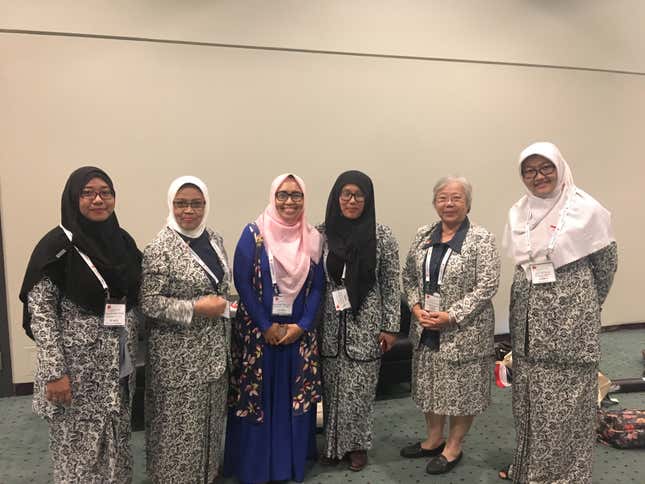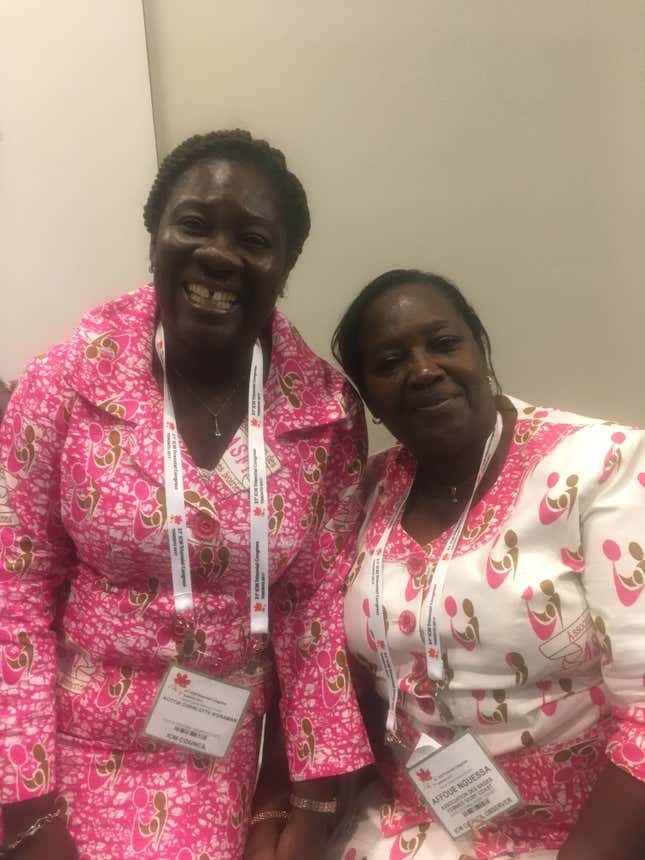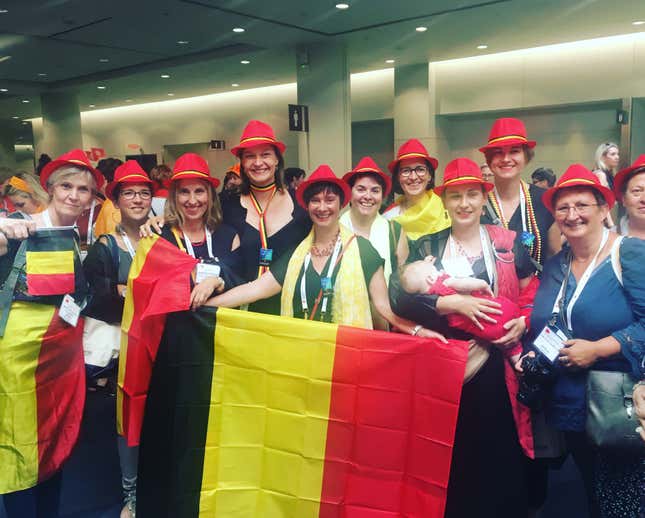
Among North America’s coastal elites, midwifery has become associated with finicky preferences, rigid orthodoxy, and a commitment to doing things right. Regular folks have hospital births. Folks who want to “win” at childbirth by forgoing the epidural, or who turn up their noses at chemicals that course through one’s body during induction—they see midwives.
Midwives themselves are often associated with a philosophical rejection of medical intervention in childbirth. Many North American women feel that midwifery subjects their choices to unwavering scrutiny—you must breastfeed until your baby is a year old, you must wear your baby. But these notions are painfully ironic because outside of the contemporary Western context, midwifery isn’t and never was for elites. It’s the actual oldest profession.

On June 18, I was in Toronto for the triennial congress of the International Confederation of Midwives, a non-governmental organization that represents approximately 300,000 midwives across 114 countries. On my way there, I had made a little joke to myself—that I was heading to a gathering of friendly women in sensible shoes. In retrospect this fleeting thought embarrasses me. In many parts of the world, a midwife is the only health care provider that a woman will ever encounter. Personal style does not enter into the equation. Associating midwives—even North American midwives—with a certain aesthetic or ideology is unimaginative and, more to the point, it’s a dismissive hand in the face of the urgent and often overlooked work of providing compassionate maternal care.
The congress’s opening ceremony felt like some kind of Women’s Health Olympics; a procession of midwives wearing outfits that represent their home countries carry their national flags into a huge hall to resounding cheers. As they walked in, the countries where midwives work under the most difficult conditions, like Somalia and Afghanistan, received extra applause.
Many midwives in attendance repped their country’s cohort of with pride. The 400-odd Australians in attendance wore bright red cowboy hats. A group from Japan wore traditional kimonos. The midwives from Indonesia wore hijabs of a particular textile that designates their professional affiliation. Midwives from Mali, Cote d’Ivoire, Zimbabwe and Ghana all wore dresses made of material printed with their midwifery associations’ name and logo. A supremely endearing group of Welsh midwives wore giant bonnets shaped like daffodils—“Wales’s national flower!” they informed me.

The ICM congress bridges a cultural gap that extends from providers of Gwyneth-approved crystal-purified birthing vibes to midwives who act as primary care providers to women in conflict-ridden corners of the developing world.* “We encompass two polar opposites between developed countries and low-resource countries,” Dr. Sally Pairman, CEO of the ICM and a midwife from New Zealand, explained to me. “In developed countries, we have a situation of ‘too much too soon.’ Too much access to resources that are deployed when they might not be helpful. In low-resource countries, it’s too little too late. No primary maternity care of any kind. Midwives working without power or water. No integration with any kind of health care infrastructure that would allow a midwife to transfer a woman to hospital should she need additional care. So we are trying to facilitate a balance in both of these contexts.”

I asked Dr. Pairman to address the perception that many Western women have that midwives oppose medical intervention. “That whole thing of ‘midwives don’t like technology’—that is complete nonsense,” she said. “I think that’s one way that our narrative of trying to raise the understanding that birth is physiology has come back to us, distorted. In the case of a low-risk birth, which most births are, we are looking to help women give birth safely. But listen, we need to remember that midwives must be making constant reassessments of a situation. Is this situation in need of intervention? How long will I need to get to the hospital? These are assessments that are made individually, and invisibly. The hidden nature of this ongoing assessment sometimes means that midwives are not taken seriously by other medical professionals.”
I asked Cora Beitel, a registered midwife in Vancouver, what they think about Western midwifery’s reputation for being judgy and doctrinaire. “Anytime you’re talking about choices that people are making as parents, there will be strong feelings. I think the perception comes more from parenting circles than from midwives themselves,” they said. “Parents want to make the best choices for their families, and then those choices become framed as ‘the right’ choices, and then you have these competing camps. It kind of comes with the territory when you have people who are working very hard to do what they think is right.”
Meanwhile, in many parts of the developing world, expectant mothers’ main concern isn’t securing approval from one’s peers, but surviving childbirth. It’s hard to find a more explicit example of global inequality than comparing the conditions in which mothers give birth in poor and rich countries. I spoke to Toyin Saraki, a Nigerian maternal health philanthropist and former lawyer who founded and runs the Wellbeing Foundation Africa. Mrs. Saraki is a member of the Nigerian Yoruba aristocracy (her formal title is “Her Excellency”), and is married to the President of the Nigerian Senate. When I asked for her card, her assistant appeared with her blue Birkin. Mrs. Saraki is one of the most elegant people I have ever sat beside. Several times I stopped transcribing our interview to enjoy listening to the incredibly soothing quality of her speaking voice, which remained soft but warmly insistent throughout our conversation. “The most pressing concern in Nigeria is to stop women from dying in childbirth,” she told me. “The best way to do that is to make sure that every woman has a midwife right from the beginning of her pregnancy.”
In Nigeria and in many other parts of the world, midwives deliver babies in hospitals when there’s a hospital available. “In my country, we don’t have an efficient medical referral system,” said Saraki. “In some rural areas women who go into labor have to walk miles to get to a hospital. Or they’re wheeled in a wheelbarrow. I like to have midwives deliver in respectful surroundings, and close to more medicalization if the mother is in need. If we were a country that had better medical referral systems I would be a proponent of home birth, certainly.”
Saraki told me that Nigerian hospitals require that women arrive to give birth with their own medical supplies. “You can imagine, in areas where we have grinding poverty, women can’t afford these materials, so they don’t seek medical care.” For many years, the Wellbeing Foundation Africa distributed “Mama kits” to expectant mothers, equipped with all the required items. Recently, Mama Kits have proven essential in camps for internally displaced people in Nigeria.
In areas where resources are scarce, midwives can help women navigate issues beyond childbirth. Female genital mutilation (FGM) continues to be widely practiced in 30 countries, and Saraki remarked that midwives are among the few people outside a family that ever find out that a woman has been circumcised. “The problem with FGM is that it’s one of the few horrible practices being done to women and girls by women. We do it to each other. It’s a cultural practice, and it runs in communities. There’s a lot of peer pressure to have it done.”
Saraki believe that midwives are among the few people that might successfully counsel a woman against continuing the tradition of FGM. “If a pregnant woman has had FGM, when she goes for delivery, the midwife will see that part of the genitals have been cut. She can counsel the woman to not do this to her own daughter. I think that the role of midwives is being the mother’s advisor and educator is crucial in ending FGM.”

I had come to Toronto fresh from having been reminded by several friends about the ways that midwifery had let them down. One friend had been handled hastily and without adequate communication in the wake of an unexpected complication in her son’s birth. Another felt that her midwife had not presented formula feeding as a viable choice, which led her to go through a hellacious three months of anxiety while trying unsuccessfully to increase her milk supply.
Many midwives I spoke to are aware that on their individual work hangs the reputation of the entire profession. While obstetricians surely feel the same pressure, I don’t think that each time an obstetrical birth goes off-script that the family is tempted to write off obstetric surgery as a field. Perhaps it’s easier for women in labour to accept advice that seems to be coming from an entire structure of medical knowledge rather than from the best judgement of one individual woman. “It’s life or death, every time,” said Dr. Pairman. “Why are midwives often treated with disrespect by their peers in the medical profession, when they are trained primary care providers? That’s something that we are trying to figure out.”
Once I’d set aside the assumptions of my East Coast milieu, I relaxed—a lot. Imagine being at a gathering of thousands of your aunts and cousins, not a single one of whom would be remotely weirded out if you needed to pull them aside for a quick question about, say, some irregular spotting you’ve been having. Many attendees had brought babies. At one standing-room-only symposium talk, a woman with a baby stood near the back of the room. “There’s a seat up here if you’d like,” beckoned the speaker.
“Well, I think he might start crying,” demurred the woman.
The room erupted in chuckles. “I doubt that anyone here will mind,” said the speaker.
Having spent years of my life navigating my young family through crowded environments where a crying baby is categorically not okay, this moment felt to me like a deep-tissue exhalation.
And, despite the variety of cultures present, there was one person who bridged it singlehandedly. During the congress, news broke that Beyonce had her twins. Midwives across the world reacted with unbridled joy.
Kathryn Jezer-Morton writes about parenting for Jezebel and is based on Montreal. Find her on Twitter at @kjezermorton.